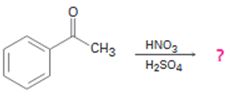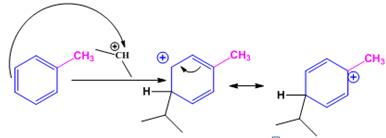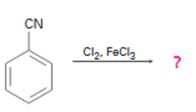
a)

Interpretation:
The product of the reaction in which actophenone reacts with HNO3 and H2SO4 is to be predicted. The observed regiochemistry is to be explained by drawing the resonance structures of the intermediates.
Concept introduction:
The carbonyl group is an electron withdrawing group. Hence in
To predict:
The product of the reaction in which actophenone reacts with HNO3 and H2SO4.
To explain:
The observed regiochemistry by drawing the resonance structures of the intermediates.
Answer to Problem 77AP
Actophenone reacts with HNO3 and H2SO4 to produce m-nitroacetophenone.
Explanation of Solution
The electrophile, NO2+, attacks the aromatic ring in the first step to produce a resonance stabilized carbocation (sigma complex). In the second step the carbocation deprotonates to yield the product. For the meta attack the intermediate is more stabilized as shown.

For ortho and para attack one of the resonance forms will be unstable as there will be a positive charge on the carbon to which the carbonyl group is attached.
Actophenone reacts with HNO3 and H2SO4 to produce m-nitroacetophenone.
b)

Interpretation:
The product of the reaction in which toluene reacts with isopropyl chloride in the presence of AlCl3 is to be predicted. The observed regiochemistry is to be explained by drawing the resonance structures of the intermediates.
Concept introduction:
Alkyl groups are an electron releasing groups. Hence during aromatic electrophilic substitution reactions the alkyl groups will activate the ring and orient the electrophile to the ortho and para positions.
To predict:
The product of the reaction in which toluene reacts with isopropyl chloride in the presence of AlCl3.
To explain:
The observed regiochemistry by drawing the resonance structures of the intermediates.
Answer to Problem 77AP
When toluene reacts with isopropyl chloride in the presence of AlCl3 the products obtained are o- and p-isopropylbenzenes. The p-isomer will predominate.
Explanation of Solution
The electrophile, (CH3)2CH+, attacks the aromatic ring in the first step to produce a resonance stabilized carbocation (sigma complex). In the second step the carbocation deprotonates to yield the product. For the ortho and para attacks, one of the the resonance structures has a positive charge on a carbon adjacent to the methyl group. This form is stabilized by electron release from the methyl group. Such stabilization is not possible for the meta attack. Hence a mixture of ortho-para products is produced in which the p-isomer predominates.
For ortho attack:

For para attack:

When toluene reacts with isopropyl chloride in the presence of AlCl3 the products obtained are o- and p-isopropylbenzenes. The p-isomer will predominate.
c)

Interpretation:
The product of the reaction in which benzonitrile reacts with chlorine in the presence of FeCl3 is to be predicted. The observed regiochemistry is to be explained by drawing the resonance structures of the intermediates.
Concept introduction:
The nitrile group is an electron withdrawing group. Hence in aromatic electrophilic substitution reactions the nitrile group will deactivate the ring and orient the electrophile to the meta position.
To predict:
The product of the reaction in which benzonitrile reacts with chlorine in the presence of FeCl3.
To explain:
The observed regiochemistry by drawing the resonance structures of the intermediates.
Answer to Problem 77AP
When benzonitrile reacts with chlorine in the presence of FeCl3 meta chlorobenzonitrile will be produced.
Explanation of Solution
The electrophile, Cl+, attacks the aromatic ring in the first step to produce a resonance stabilized carbocation (sigma complex). In the second step the carbocation deprotonates to yield the product. For the meta attack the intermediate is more stabilized as shown.

For ortho and para attack one of the resonance forms will be unstable as there will be a positive charge on the carbon to which the nitrile group is attached.
When benzonitrile reacts with chlorine in the presence of FeCl3 meta chlorobenzonitrile will be produced.
d)

Interpretation:
The product of the reaction in which methoxy benzene reacts with iodine in the presence of CuCl2 is to be predicted. The observed regiochemistry is to be explained by drawing the resonance structures of the intermediates.
Concept introduction:
Methoxy group is an electron releasing group. Hence during aromatic electrophilic substitution reactions the methoxy group will activate the ring and orient the electrophile to the ortho and para positions.
To predict:
The product of the reaction in which benzene reacts with iodine in the presence of CuCl2.
To explain:
The observed regiochemistry by drawing the resonance structures of the intermediates.
Answer to Problem 77AP
When methoxybenzene reacts with iodine in the presence of CuCl2, the products obtained are o- and p-iodobenzenes.
Explanation of Solution
Iodine itself is unreactive toward aromatic rings. CuCl2 accelerate the iodination reaction by oxidizing iodine to a more powerful by electrophilic species that reacts like I+.

The electrophile, I+, attacks the aromatic ring in the first step to produce a resonance stabilized carbocation (sigma complex). In the second step the carbocation deprotonates to yield the product. For the ortho and para attacks, one of the the resonance structures has a positive charge on a carbon adjacent to the methoxy group. This form is stabilized by electron release from the methoxy group. Such stabilization is not possible for the meta attack. Hence a mixture of ortho-para products is produced.
Ortho attack:

Meta attack:

When methoxybenzene reacts with iodine in the presence of CuCl2, the products obtained are o- and p-iodobenzenes.
Want to see more full solutions like this?
Chapter 16 Solutions
Study Guide with Student Solutions Manual for McMurry's Organic Chemistry, 9th
- Would the following organic synthesis occur in one step? Add any missing products, required catalysts, inorganic reagents, and other important conditions. Please include a detailed explanation and drawings showing how the reaction may occur in one step.arrow_forwardBelow is the SN1 reaction of (S)-3-chlorocyclohexene and hydroxide (OH). Draw the missing curved arrows, lone pairs of electrons, and nonzero formal charges. In the third box, draw the two enantiomeric products that will be produced. 5th attempt Please draw all four bonds at chiral centers. Draw the two enantiomeric products that will be produced. Draw in any hydrogen at chiral centers. 1000 4th attempt Feedback Please draw all four bonds at chiral centers. 8. R5 HO: See Periodic Table See Hint H Cl Br Jid See Periodic Table See Hintarrow_forwardShow that a molecule with configuration π4 has a cylindrically symmetric electron distribution. Hint: Let the π orbitals be equal to xf and yf, where f is a function that depends only on the distance from the internuclear axis.arrow_forward
- (a) Verify that the lattice energies of the alkali metal iodides are inversely proportional to the distances between the ions in MI (M = alkali metal) by plotting the lattice energies given below against the internuclear distances dMI. Is the correlation good? Would a better fit be obtained by plotting the lattice energies as a function of (1 — d*/d)/d, as theoretically suggested, with d* = 34.5 pm? You must use a standard graphing program to plot the graph. It generates an equation for the line and calculates a correlation coefficient. (b) From the graph obtained in (a), estimate the lattice energy of silver iodide. (c) Compare the results of (b) with the experimental value of 886 kJ/mol. If they do not agree, explain the deviation.arrow_forwardCan I please get help with #3 & 4? Thanks you so much!arrow_forwardA solution consisting of 0.200 mol methylbenzene, C,H,CH,, in 500. g of nitrobenzene, CH,NO₂, freezes at 3.2°C. Pure nitrobenzene freezes at 6.0°C. The molal freezing point constant of nitrobenzene is _ °C/m. a) 2.8 b) 3.2 c) 5.6 d) 7.0 e) 14.0arrow_forward
- Below is the SN1 reaction of (S)-3-chlorocyclohexene and hydroxide ("OH). Draw the missing curved arrows, lone pairs of electrons, and nonzero formal charges. In the third box, draw the two enantiomeric products that will be produced. 2nd attempt Please draw all four bonds at chiral centers. 0 D Draw the missing curved arrow notation. Add lone pairs of electrons and nonzero formal charges. + 노 V 1st attempt Feedback Please draw all four bonds at chiral centers. See Periodic Table See Hint F P 41 H Br See Periodic Table See Hint H Larrow_forwardHow close are the Mulliken and Pauling electronegativity scales? (a) Now that the ionization energies and electron affinities have been defined, calculate the Mulliken and Pauling electronegativities for C, N, O and F. Compare them. (Make the necessary adjustments to the values, such as dividing the ionization energies and electron affinities by 230kj/mol) (b) Plot both sets of electronegativities against atomic number (use the same graph). (c) Which scale depends most consistently on position in the Periodic Table?arrow_forwardBelow is the SN2 reaction between 2-bromopropane and iodide (I). Draw the mechanism arrows in the first box to reflect electron movements. In both boxes, add lone pairs of electrons and nonzero formal charges. 4th attempt Feedback 3rd attempt Feedback 1 -Br H :Bri :Br: ili See Periodic Table See Hint ini See Periodic Table See Hintarrow_forward
- When 4-chloro-1-butanol is placed in sodium hydride, a cyclization reaction occurs. 3rd attempt 2 HO NaH CI D Draw the curved arrow notation to form the intermediate. 4 2 H₂ See Periodic Table See Hint =arrow_forwardSketch, qualitatively, the potential energy curves of the N-N bond of N2H4, N2 and N3- graph. Explain why the energy at the minimum of each curve is not the same.arrow_forward(a) Show that the lattice energies are inversely proportional to the distance between ions in MX (M = alkali metal, X = halide ions) by plotting the lattice energies of KF, KCl, and KI against the internuclear distances, dMX. The lattice energies of KF, KCl, and KI are 826, 717, and 645 kJ/mol, respectively. Does the correlation obtained correlate well? You will need to use a standard graphing program to construct the graph (such as a spreadsheet program). It will generate an equation for the line and calculate a correlation coefficient. (b) Estimate the lattice energy of KBr from your graph. (c) Find an experimental value for the lattice energy of KBr in the literature, and compare this value with the one calculated in (b). Do they agree?arrow_forward

 Organic ChemistryChemistryISBN:9781305580350Author:William H. Brown, Brent L. Iverson, Eric Anslyn, Christopher S. FootePublisher:Cengage Learning
Organic ChemistryChemistryISBN:9781305580350Author:William H. Brown, Brent L. Iverson, Eric Anslyn, Christopher S. FootePublisher:Cengage Learning Organic Chemistry: A Guided InquiryChemistryISBN:9780618974122Author:Andrei StraumanisPublisher:Cengage Learning
Organic Chemistry: A Guided InquiryChemistryISBN:9780618974122Author:Andrei StraumanisPublisher:Cengage Learning


